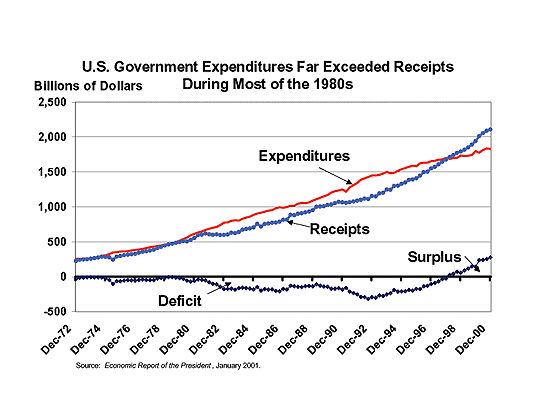The federal government debt held by the public indeed soared through the 1980s and into the 1990s, before peaking in 1997 and starting to decline in 1998. U.S. Treasury debt held by the public is a more useful measure for analyzing the size of the national debt than gross debt. Gross debt includes debt owed by one federal governmental entity to another federal government entity or trust fund.
|
Composition of Federal Debt
End of Year 2000 |
||
|
Trillions of Dollars
|
||
| Gross Federal Debt |
$5.6
|
|
|
||
|
$1.7
|
|
|
$0.5
|
|
|
$3.4
|
|
| Source: Economic Report of the President, January 2001. Federal Reserve Statistical Release, H.4.1, December 28, 2000. | ||
Rising Debt
About one-half of the publicly held federal government debt outstanding at the end of 2000 was accumulated in the 1980s. This increase in the level of federal debt held by the public can be observed by viewing Chart A, which graphs the outstanding national debt held by the public at the end of each year from 1963 to 2000.
CHART A

The large amount of publicly held U.S. Treasury debt shown in Chart A also has implications for current budgets, since the Treasury must make interest payments on the outstanding debt. In 2000, for example, the interest payments on the federal government debt added $222.8 billion to government expenditures.
What Caused the Debt to Grow?
During the 1980s, federal government receipts fell well below government expenditures. As the U.S. Treasury borrowed (by issuing Treasury bills, notes, and bonds) to pay its bills, there was a marked increase in the size of the national debt. Chart B shows the path of government expenditures and receipts for the period from 1972 to 2000.
CHART B

It is likely that several forces accounted for both the large annual deficits, also shown in Chart B, and ultimately the $1.7 trillion increase in the national debt in the hands of the public during the period from 1980 to 1990. Three important contributing factors were as follows:
- Receipts fell following the implementation of reductions in both personal and business taxes in 1981.
- Expenditures on the defense budget increased.
- Expenditure cuts proposed for many nondefense budget items were not enacted.2
Finally, since the first quarter of 1998, federal government receipts have been running ahead of expenditures, creating an annual surplus (also shown in Chart B). Since 1998 the surplus has led to the reduction in outstanding publicly held national debt shown in Chart A.
Endnotes:
References:
Economic Report of the President. 2001. Council of Economic Advisors, U.S. Government Printing Office, Washington, January 2001, Statistical Tables, Government Finance.
Federal Reserve Bulletin. 2000. Board of Governors of the Federal Reserve System, December 2000, See Table A-27, Financial and Business Statistics.
Federal Reserve Statistical Release, H.4.1, "Factors Affecting Reserve Balances," Board of Governors of the Federal Reserve System, December 28, 2000. http://www.federalreserve.gov/releases/H41/20001228/
Samuelson, Paul A., and William D. Nordhaus. 1998. Economics, Irwin McGraw-Hill, Boston, pages 644-653.
Throop, Adrian W. 1990. "The Burden of Reagan Debt." FRBSF Weekly Letter, Federal Reserve Bank of San Francisco, April 20, 1990.